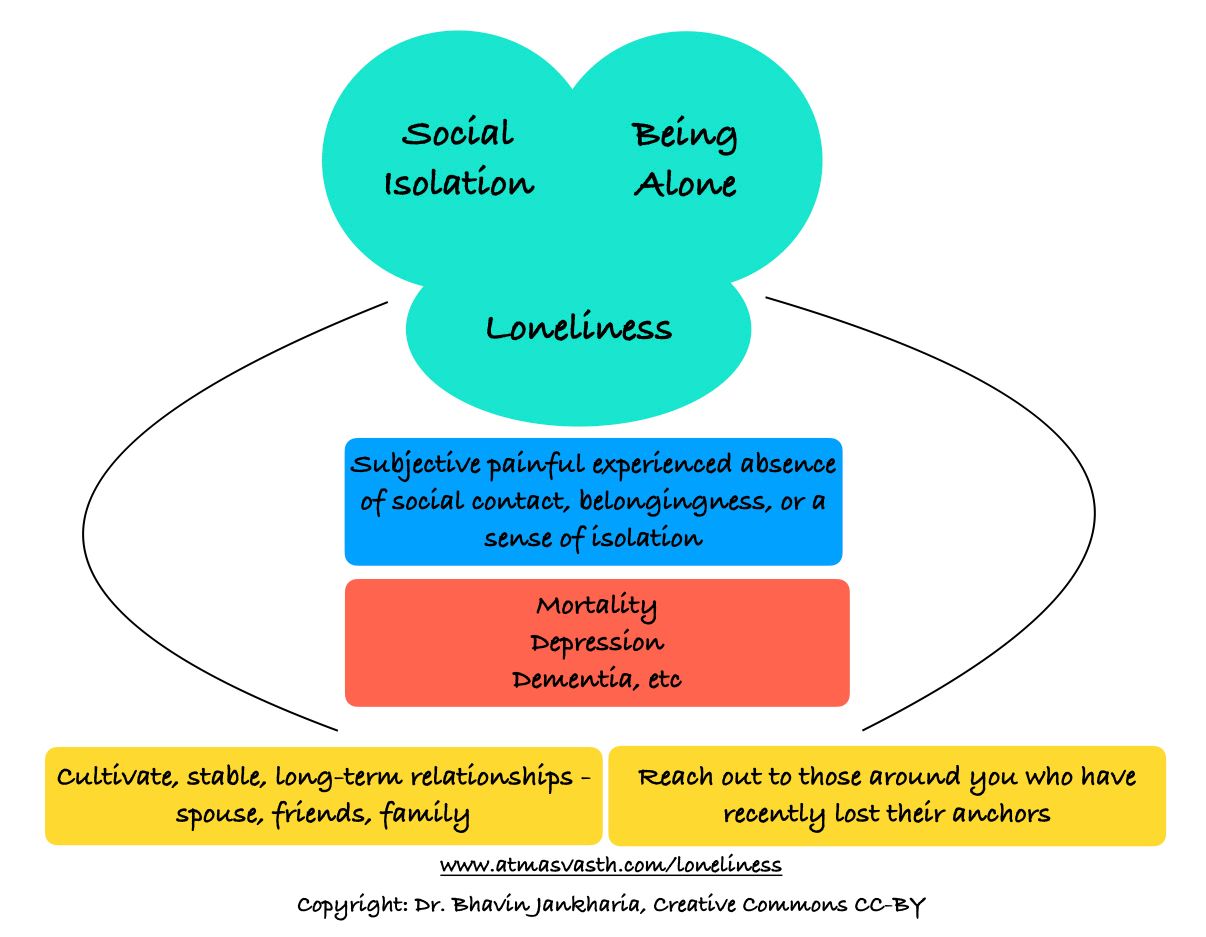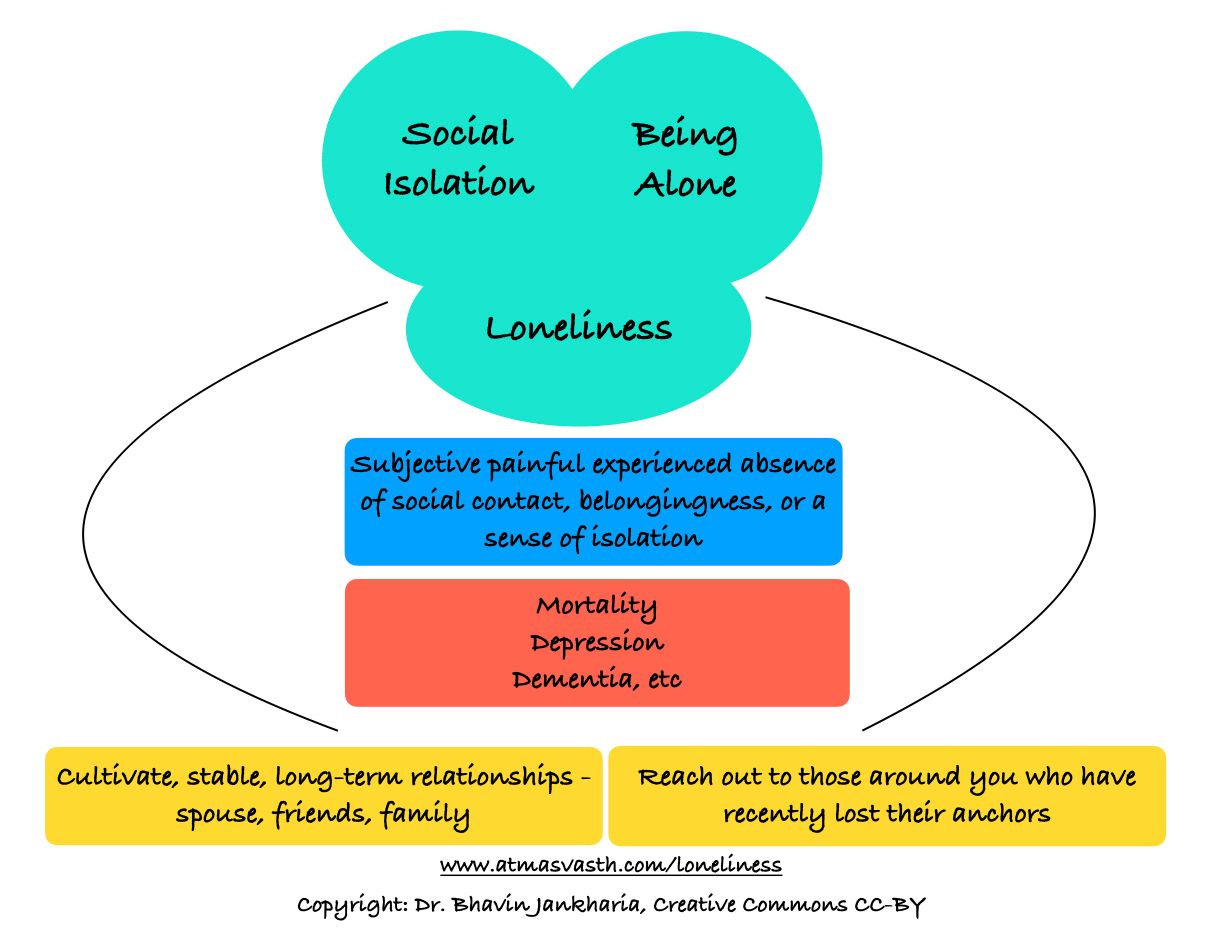Being Alone and Being Lonely are Two Different Things
Being alone and being lonely are two different things. It’s nice to be alone, but it’s not nice to be lonely.

You can listen to the audio/podcast hosted on Soundcloud by clicking the Play button below within the browser itself. You can click here to access directly from your email.
One important component of our healthy / happy 7 list is “Cultivating stable, long-term relationships - spouse, friends and family”, that I spoke and wrote about last week.
This reminded me of Baz Luhrman’s song, “Everybody is Free to Wear Sunscreen”, which has these lyrics in the middle.
Get to know your parents, you never know when they'll be gone for good
Be nice to your siblings, they're your best link to your past
And the people most likely to stick with you in the future
Understand that friends come and go
But with a precious few, you should hold on
Work hard to bridge the gaps in geography and lifestyle
For as the older you get
The more you need the people you knew when you were young
Loneliness, social isolation and being alone are all often used interchangeably, but are not the same. Social isolation refers to a lack of social contact, which can be objectively quantified (e.g. living alone, without a partnership) [1]. Loneliness is defined subjectively as a painfully experienced absence of social contact, belongingness, or a sense of isolation [1]. Being alone is just that, a state or a point in time, often desirable, when you don’t have anyone near you, physically and/or mentally.
As Sarah Adler, PsyD says “Being alone is actually just a state; it means that you are not with other people. Loneliness is an emotion, which describes a feeling of sadness attributed to not having connection." [2]
For example, I am currently writing this piece at Delhi airport. I am sitting alone, I have my AirPods plugged into my ears without music to reduce the constant hum around me. While I am surrounded by hundreds of people, I am pleasurably on my own, alone, able to think and write. If I found this painful or sad, then that would mean I was lonely, which you can be even in a crowd of people, if you are unable to connect. Social isolation, being alone and loneliness are linked, but they are not the same.
Cultivating relationships with a spouse, with friends and family as Arthur C Brooks says, makes a difference. It allows us to connect with people, to share our thoughts and feelings and to spend time with them, with the confidence and understanding that they also have our backs as we have theirs. The poets, writers, philosophers have gotten it right for more than two millennia…we now have objective data as well.
A recent article in Neurology by Joel Salinas and colleagues [3], based on the Framingham cohort showed those who were lonely had an increased dementia risk over 10 years. Another study that analyzed the Gutenberg cohort showed a similar correlation between loneliness and depression, suicidal ideation and poor health behavior and healthcare utilization [1].
The extent of social isolation and loneliness varies from country to country and society to society. Interestingly, one study [4] that compared the prevalence of loneliness and its correlation with mortality, in the LMICs (low middle income countries) found a prevalence of loneliness of 18.3% in India, 3.8% in China and 25.3 to 32.4% in the Latin American countries. Except in India, a definite correlation was found between the presence of loneliness and increasing mortality, including in China, despite the low prevalence rate of loneliness. There was however no obvious reason given for the lack of correlation between loneliness and mortality among Indians. Was it due to cultural differences in the definition or understanding of loneliness? The authors did not explain.
However, Supe Pengpid and Karl Pedtzer in an analysis of the LASI (Longitudinal Ageing Study in India) cohort found a definite correlation between loneliness and poor physical and mental health, with a prevalence of 20% of moderate and 13.3 % of severe loneliness among 72, 262 middle aged and older adults [5].
While even the young can be lonely, loneliness increases with age, especially as people around us start leaving and dying and we are unable to make new friends or connect with those around us. Which is why as Baz says,
Work hard to bridge the gaps in geography and lifestyle
For as the older you get
The more you need the people you knew when you were young
And it’s not just that. The younger lot, the children and grand-children and friends also need to make an effort to reach out to those who have recently become socially isolated or alone, especially if they have lost the crutch of a spouse of 4 to 5 decades to ensure that the recently bereaved don’t slip away forgotten.

C Y Gopinath wrote a telling piece about this in the Mid-Day and made this statement, which explains what his article is all about. “The real sadness of being a woman living alone in her declining years is not that people don’t notice it when you die. It is that they do not even realise you’re alive”. These were women who as they grew older, lived or are living alone, lonely and then died or are going to die alone, lonely.
It’s nice to be alone, but it's not nice to be lonely. I find the absence of noise, whether physical or digital, invigorating. I find most frenetic parties, weddings and events painful. And yet, I am connected and in touch with my friends and family. You can be active on WhatsApp, Facebook and Twitter and still be lonely, while you can stay silent and aloof on social media and still have flourishing relationships. I sometimes wonder if it is the fear of loneliness that drives people to connect indiscriminately without filters on social media, while dangerously cutting back on physical meetings or phone calls and other older hacks that would allow them to connect better with those who make a difference to their lives and can help them lead happier and more fulfilled lives.
In our healthful ageing quest, the atmasvasth way, figuring out how not to be lonely is one more thing to add to our list of things to take care of.
Footnotes
1. Beutel ME et al. BMC Psych 2017;17:97
2. https://www.wellandgood.com/difference-between-being-alone-being-lonely/
3. Salinas J et al. Neurology. Online first Feb 07, 2022.
4. Gan Q et al. Int J Public Health 2021;66:60449
5. Pengpid S et al. Geriatric Psychiatry 2021;36:1722
Atmasvasth Newsletter
Join the newsletter to receive the latest updates in your inbox.